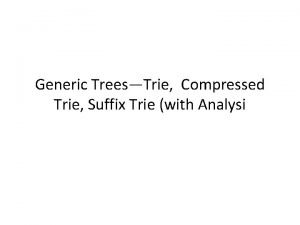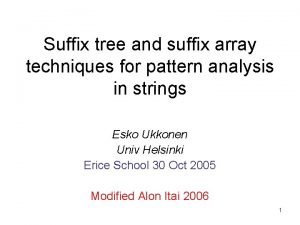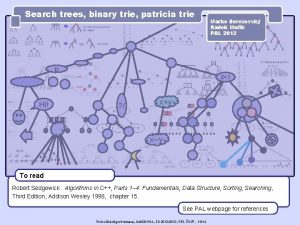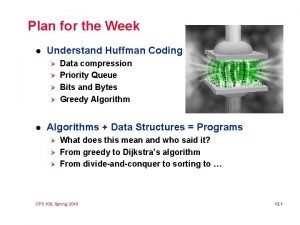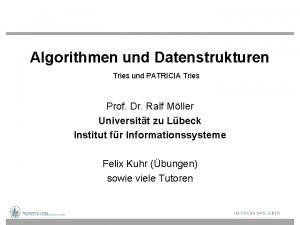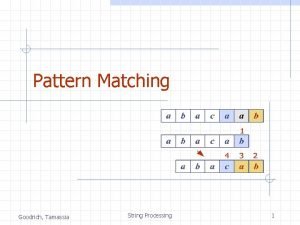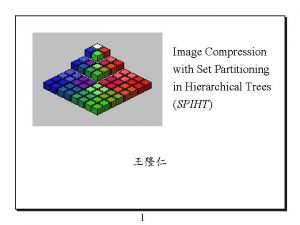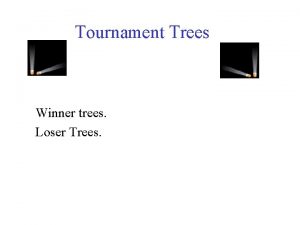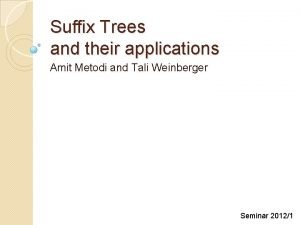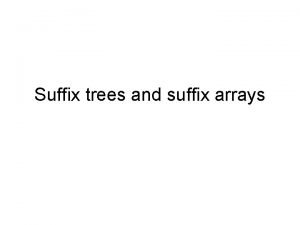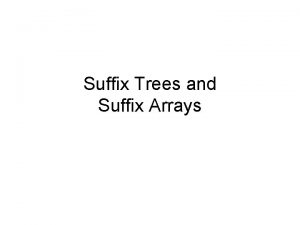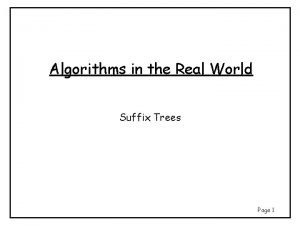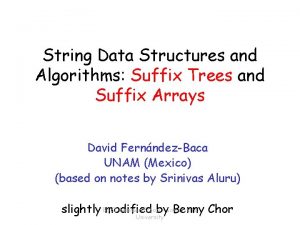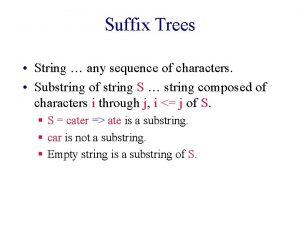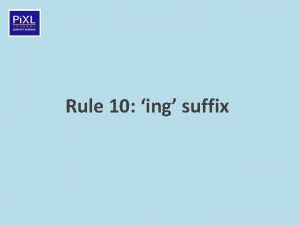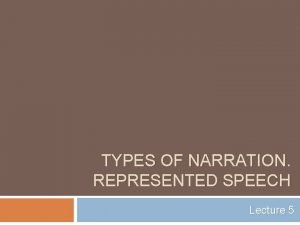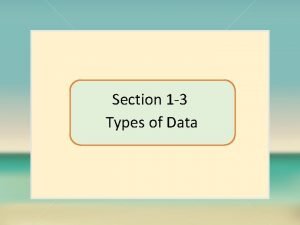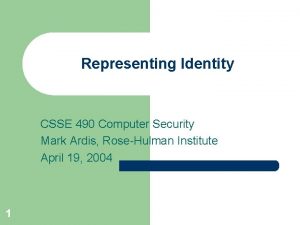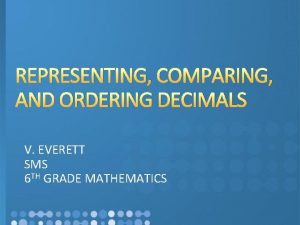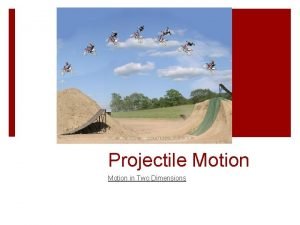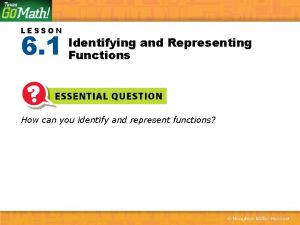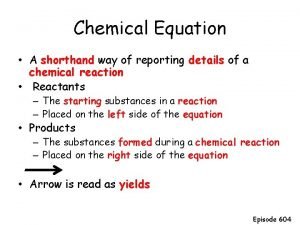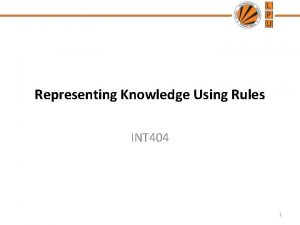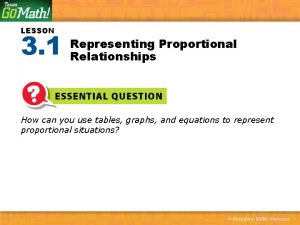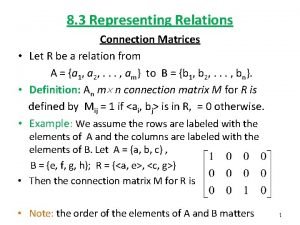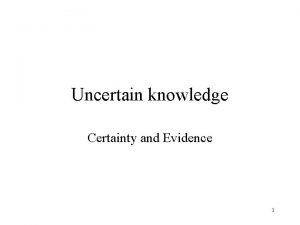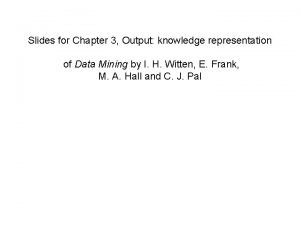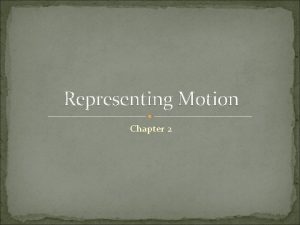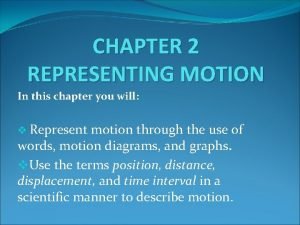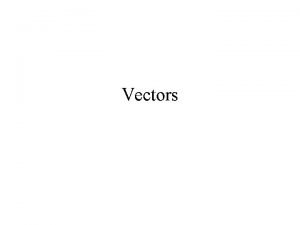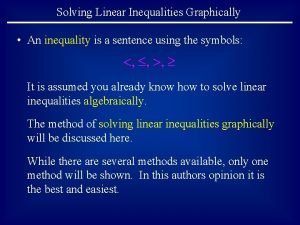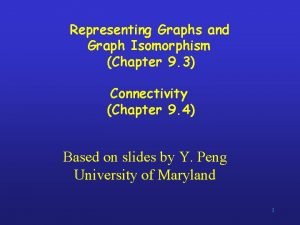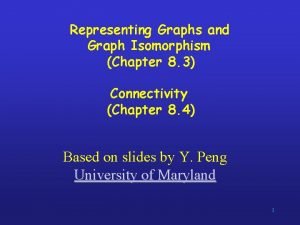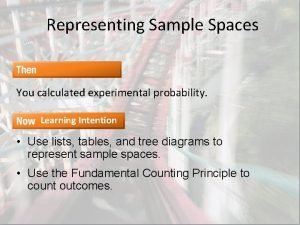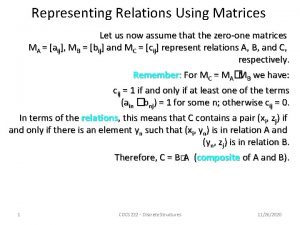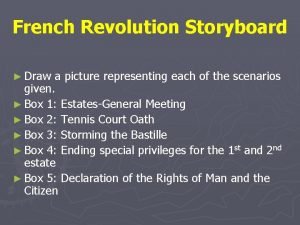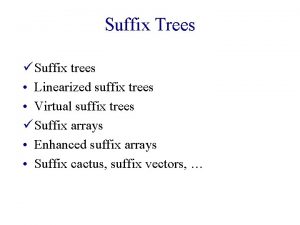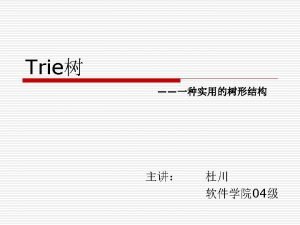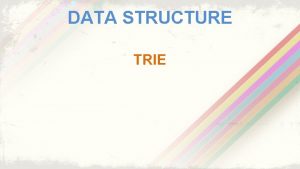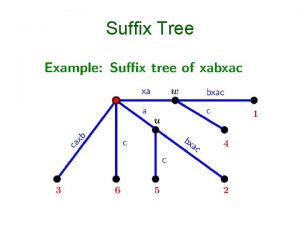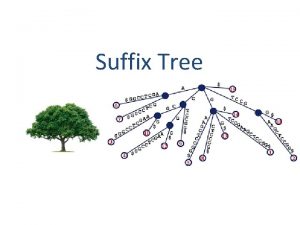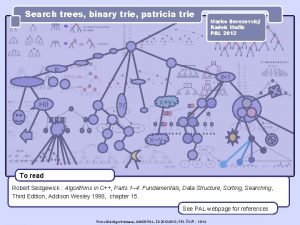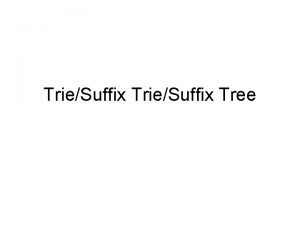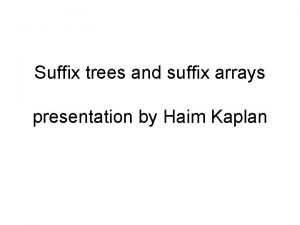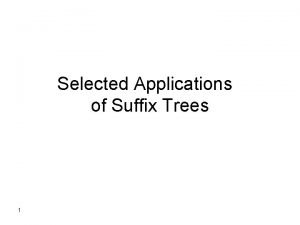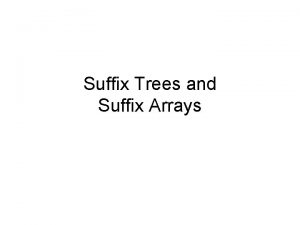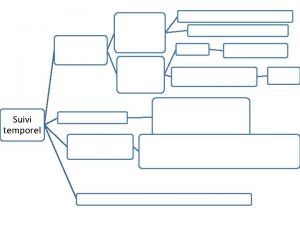Suffix trees Trie A tree representing a set





















































![Compression S[1. . n]= aabcbbabbsbabcbbbbabbabcbbabbabbsb… aabcbbabbsb (2, 5) bbabbabcbbabbabbsb… Compression S[1. . n]= aabcbbabbsbabcbbbbabbabcbbabbabbsb… aabcbbabbsb (2, 5) bbabbabcbbabbabbsb…](https://slidetodoc.com/presentation_image_h2/62a259452848992a54f47bb147c4ab41/image-54.jpg)
![Compression S[1. . n]= aabcbbabbsbabcbbbbabbabcbbabbabbsb… aabcbbabbsb (2, 5) bbabbabcbbabbabbsb… נגדיר Priori=S[i. . i+Li-1] הרישה Compression S[1. . n]= aabcbbabbsbabcbbbbabbabcbbabbabbsb… aabcbbabbsb (2, 5) bbabbabcbbabbabbsb… נגדיר Priori=S[i. . i+Li-1] הרישה](https://slidetodoc.com/presentation_image_h2/62a259452848992a54f47bb147c4ab41/image-55.jpg)
![Compression S[1. . n]= aabcbbabbsbabcbbbbabbabcbbabbabbsb… aabcbbabbsb (2, 5) bbabbabcbbabbabbsb… נגדיר Priori=S[i. . i+Li-1] הרישה Compression S[1. . n]= aabcbbabbsbabcbbbbabbabcbbabbabbsb… aabcbbabbsb (2, 5) bbabbabcbbabbabbsb… נגדיר Priori=S[i. . i+Li-1] הרישה](https://slidetodoc.com/presentation_image_h2/62a259452848992a54f47bb147c4ab41/image-56.jpg)
![Compression S[1. . m]= aabcbbabbsbabcbbbbabbabcbbabbabbsb… i=12 aabcbbabbsb (2, 5) bbabbabcbbabbabbsb… (s 12, L 12) Compression S[1. . m]= aabcbbabbsbabcbbbbabbabcbbabbabbsb… i=12 aabcbbabbsb (2, 5) bbabbabcbbabbabbsb… (s 12, L 12)](https://slidetodoc.com/presentation_image_h2/62a259452848992a54f47bb147c4ab41/image-57.jpg)


![root computing (si, Li): a |a| + cv ≤ i p S[ n] i. root computing (si, Li): a |a| + cv ≤ i p S[ n] i.](https://slidetodoc.com/presentation_image_h2/62a259452848992a54f47bb147c4ab41/image-60.jpg)






- Slides: 66

Suffix trees

Trie • A tree representing a set of strings. a { aeef ad bbfe bbfg c } e d c b b e f f c e g

Trie (Cont) • Assume no string is a prefix of another Each edge is labeled by a letter, no two edges outgoing from the same node are labeled the same. a e Each string corresponds to a leaf. d c b b e f f c e g

Compressed Trie • Compress unary nodes, label edges by strings a e d c b e bbf d eef f c c a b e f g c e g

Suffix tree Given a string s a suffix tree of s is a compressed trie of all suffixes of s To make these suffixes prefix-free we add a special character, say $, at the end of s

Suffix tree (Example) Let s=abab, a suffix tree of s is a compressed trie of all suffixes of s=abab$ $ { $ b$ ab$ bab$ a b a b $ $ } Note that a suffix tree has O(n) nodes n = |s| (why? )

Trivial algorithm to build a Suffix tree Put the largest suffix in Put the suffix bab$ in a b a b $

a b $ b a b $ a b b a b $ Put the suffix ab$ in a b $ $

a b $ Put the suffix b$ in $ a b $ b a b $ $

a b $ b a b $ $ Put the suffix $ in a b $ b $ a b $ $

$ a b $ b $ a b $ $ We will also label each leaf with the starting point of the corres. suffix. $ a b 5 b $ a a 4 $ b b $ 3 $ 1 2

Analysis Takes O(n 2) time to build. You can do it in O(n) time But, how come? does it take O(n) space ?

Linear space ? • Consider the string aaaaaabbbbbb $ a a c a abbbbbb$ bbbbbb$ bbbbbb$ $ b $ b b$ $

To use only O(n) space encode the edge-labels • Consider the string aaaaaabbbbbb $ a a c a abbbbbb$ b (7, 13) bbbbbb$ $ b $ b b$ $

To use only O(n) space encode the edge-labels • Consider the string aaaaaabbbbbb (13, 13) (1, 1) (7, 13) (1, 1) c (6, 13) (7, 13) (7, 7) (13, 13) (7, 7) (12, 13) (13, 13)

What can we do with it ? Exact string matching: Given a Text T, |T| = n, preprocess it such that when a pattern P, |P|=m, arrives you can quickly decide if it occurs in T. We may also want to find all occurrences of P in T

Exact string matching In preprocessing we just build a suffix tree in O(n) time $ a b 5 b $ a a 4 $ b b $ 3 $ 1 2 Given a pattern P = ab we traverse the tree according to the pattern.

$ a b $ 1 b $ 3 5 $ a b $ 4 2 If we did not get stuck traversing the pattern occurs in the text. Each leaf in the subtree below the node we reach corresponds to an occurrence. By traversing this subtree we get all k occurrences in O(n+k) time

Generalized suffix tree Given a set of strings S a generalized suffix tree of S is a compressed trie of all suffixes of s S To associate each suffix with a unique string in S add a different special char to each s

Generalized suffix tree (Example) Let s 1=abab and s 2=aab here is a generalized suffix tree for s 1 and s 2 { $ b$ ab$ bab$ abab$ } a # b# aab# b # $ 4 5 # a a $ b b 4 # $ b a b $ 1 $ # 3 1 2 2 3

So what can we do with it ? Matching a pattern against a database of strings

Longest common substring (of two strings) Every node with a leaf descendant from string s 1 and a leaf descendant from a string s 2 represents a common substring. $ 4 5 # A maximal common substring corresponds to such node. a b $ 1 Find such node with largest “string depth” b # a a $ b b 4 # $ b $ # 3 1 2 2 3

Lowest common ancetors A lot more can be gained from the suffix tree if we preprocess it so that we can answer LCA queries on it

Why? The LCA of two leaves represents the longest common prefix (LCP) of these 2 suffixes a b # $ 4 5 # a a $ b b 4 # $ b a b $ 1 $ # 3 1 2 2 3

Lowest common ancestors

Write an Euler tour of the tree 0 3 Shallowest node 12 8 9 3 1 1 2 4 5 6 2 4 3 5 7 11 10 7 LCA(1, 5) = 3 6 2 3 1 4 1 7 1 3 5 6 5 3

0 3 12 8 9 3 1 4 5 6 2 5 1 2 4 7 7 11 10 minimum 6 3 2 3 1 4 1 7 1 3 5 6 5 3 0 1 2 1 0

Range minimum 0 Preprocess an array, such that given i, j you can find the minimum in [i, j] fast 3 12 8 9 3 1 4 5 6 2 5 1 2 4 7 7 11 Reduction takes linear time 10 minimum 6 3 2 3 1 4 1 7 1 3 5 6 5 3 0 1 2 1 0

Trivial algorithms for RMQ • O(n) space, O(n) query time • O(n 2) space, O(1) query time

Less trivial algorithms to RMQ • Try to use O(nlog(n)) space to do a query in O(1) time. .

Lowest common ancetors A lot more can be gained from the suffix tree if we preprocess it so that we can answer LCA queries on it

Why? The LCA of two leaves represents the longest common prefix (LCP) of these 2 suffixes a b # $ 4 5 # a a $ b b 4 # $ b a b $ 1 $ # 3 1 2 2 3

Finding maximal palindromes • A palindrome: caabaac, cbaabc • Want to find all maximal palindromes in a string s Let s = cbaaba The maximal palindrome with center between i-1 and i is the LCP of the suffix at position i of s and the suffix at position n-i+1 of sr

Maximal palindromes algorithm Prepare a generalized suffix tree for s = cbaaba$ and sr = abaabc# For every i, find the LCA of suffix i of s and suffix n-i+1 of sr

Let s = cbaaba$ then sr = abaabc# a a $ # 3 a $ 3 a a b c # 1 # c a 6 c b b 4 $ 4 b 5 $ a b a $ 2 $ c c # # 7 b a 6 a 5 c # 2 b a $ 1 7

Analysis O(n) time to identify all palindromes

• In fact we have seen binary tries already • In מבוא מורחב

Huffman trees/codes

Compression Represent data as a sequence of 0’s and 1’s Sequence: BACADAEAFABBAAAGAH A fixed length code: A 000 B 001 C 010 D 011 E 100 F 101 G 110 H 111 Encoding of sequence: 00100000110000010100000100100000110000111 The Encoding is 18 x 3=54 bits long. Can we make the encoding shorter?

Variable Length Code Make use of frequencies. Frequency of A=8, B=3, others 1. A 0 B 100 C 1010 D 1011 E 1100 F 1101 G 1110 H 1111 Example: BACADAEAFABBAAAGAH 10001011011000110101001000001111 42 bits (20% shorter) But how do we decode?

Prefix code Binary trie Prefix code: No codeword is a prefix of any other codeword A 0 0 1 B 100 C 1010 D 1011 E 1100 F 1101 G 1110 H 1111 A 0 0 1 1 B 0 1 C D 0 E 1 F 0 G 1 H

Decoding Example 0 10001010 BAC 1 A 0 0 1 1 B 0 1 C D 0 E 1 F 0 G 1 H

Huffman Tree = Optimal Length Code 0 0 1 8 A 0 0 3 B 1 0 1 0 1 C D 1 1 1 0 E F G 1 1 1 0 0 0 1 H B C 1 3 1 1 1 D 1 1 1 0 E F G H 1 1 0 Optimal: no code has better weighted average length 1

Huffman’s Algorithm Build tree bottom-up, so that lowest weight leaves are farthest from the root. Repeatedly: Find two trees of lowest weight. merge them to form a new tree whose weight is the sum of their weights.

Construction of Huffman tree 17 9 4 5 2 B A 8 3 1 2 C D 1 2 E 1 F 1 G 1 1 H

Two questions • Why does the algorithm produce the best tree ? • How do you implement it efficiently ?

Implementation Huffman(C) n ← |C| Q←C for i ← 1 to n-1 do new(z) left(z) ← x ← delete-min(Q) right(z) ← y ← delete-min(Q) f(z) ← f(x) + f(y) insert(z, Q) return delete-min(Q)

Correctness By induction Assume we get the optimal tree to the problem with z replacing x and y, f(z) = f(x) + f(y) T H z y x H is optimal for the smaller problem by induction, and we need to prove that T is optimal

Correctness (cont) T H z y Note that: cost(T) = cost(H) + f(x) + f(y) Assume T is not optimal, there is a cheaper T’: cost(T’) < cost(T) x

Clearly T’ is full Take the deepest pair of leaves, and replace them with x and y; cost may not increase T’ y x a T’ So we may assume that T’ looks like this: a x y

From T’ we can get a solution to the problem with z instead of x and y: H’ T’ a a x y cost(T’) = cost(H’) + f(x) + f(y) z

We can now conclude: T H z y x cost(T) = cost(H) + f(x) + f(y) H’ T’ a a z x y cost(T’) = cost(H’) + f(x) + f(y) cost(T’) < cost(T) cost(H’) < cost(H), a contradiction

Compression Huffman code just uses the frequencies, does not use context We will gain much more if we use context
![Compression S1 n aabcbbabbsbabcbbbbabbabcbbabbabbsb aabcbbabbsb 2 5 bbabbabcbbabbabbsb Compression S[1. . n]= aabcbbabbsbabcbbbbabbabcbbabbabbsb… aabcbbabbsb (2, 5) bbabbabcbbabbabbsb…](https://slidetodoc.com/presentation_image_h2/62a259452848992a54f47bb147c4ab41/image-54.jpg)
Compression S[1. . n]= aabcbbabbsbabcbbbbabbabcbbabbabbsb… aabcbbabbsb (2, 5) bbabbabcbbabbabbsb…
![Compression S1 n aabcbbabbsbabcbbbbabbabcbbabbabbsb aabcbbabbsb 2 5 bbabbabcbbabbabbsb נגדיר PrioriSi iLi1 הרישה Compression S[1. . n]= aabcbbabbsbabcbbbbabbabcbbabbabbsb… aabcbbabbsb (2, 5) bbabbabcbbabbabbsb… נגדיר Priori=S[i. . i+Li-1] הרישה](https://slidetodoc.com/presentation_image_h2/62a259452848992a54f47bb147c4ab41/image-55.jpg)
Compression S[1. . n]= aabcbbabbsbabcbbbbabbabcbbabbabbsb… aabcbbabbsb (2, 5) bbabbabcbbabbabbsb… נגדיר Priori=S[i. . i+Li-1] הרישה הארוכה ביותר אשר מופיעה כתת מחרוזת - S[1. . i-1] ב
![Compression S1 n aabcbbabbsbabcbbbbabbabcbbabbabbsb aabcbbabbsb 2 5 bbabbabcbbabbabbsb נגדיר PrioriSi iLi1 הרישה Compression S[1. . n]= aabcbbabbsbabcbbbbabbabcbbabbabbsb… aabcbbabbsb (2, 5) bbabbabcbbabbabbsb… נגדיר Priori=S[i. . i+Li-1] הרישה](https://slidetodoc.com/presentation_image_h2/62a259452848992a54f47bb147c4ab41/image-56.jpg)
Compression S[1. . n]= aabcbbabbsbabcbbbbabbabcbbabbabbsb… aabcbbabbsb (2, 5) bbabbabcbbabbabbsb… נגדיר Priori=S[i. . i+Li-1] הרישה הארוכה ביותר Prior 12=abcbb מחרוזת כתת מופיעה אשר L 12=5 - S[1. . i-1] ב
![Compression S1 m aabcbbabbsbabcbbbbabbabcbbabbabbsb i12 aabcbbabbsb 2 5 bbabbabcbbabbabbsb s 12 L 12 Compression S[1. . m]= aabcbbabbsbabcbbbbabbabcbbabbabbsb… i=12 aabcbbabbsb (2, 5) bbabbabcbbabbabbsb… (s 12, L 12)](https://slidetodoc.com/presentation_image_h2/62a259452848992a54f47bb147c4ab41/image-57.jpg)
Compression S[1. . m]= aabcbbabbsbabcbbbbabbabcbbabbabbsb… i=12 aabcbbabbsb (2, 5) bbabbabcbbabbabbsb… (s 12, L 12) נגדיר Priori=S[i. . i+Li-1] הרישה הארוכה ביותר Prior 12=abcbb מחרוזת כתת מופיעה אשר L 12=5 - S[1. . i-1] ב s 12=2

“Ziv-Lempel” compression For (i=1 ; i<=n ; ; ) {Compute (si, Li) if Li>1 {output(si, Li); i=i+Li}; else {output(S[i]); i=i+1}} aabcbbabbsbabbbbbabbabcbbabbabbsb… aabcbb bs (si, Li) איך לחשב את (2, 2) (6, 4)

Implementation using suffix tree Before compression: • Build a suffix tree T for S. • For each node v, compute cv : – the smallest leaf index in v’s subtree. – the starting position of the leftmost copy of the substring that labels the path from the root to v. • O(n) time.
![root computing si Li a a cv i p S n i root computing (si, Li): a |a| + cv ≤ i p S[ n] i.](https://slidetodoc.com/presentation_image_h2/62a259452848992a54f47bb147c4ab41/image-60.jpg)
root computing (si, Li): a |a| + cv ≤ i p S[ n] i. . . v cv i |a| leaf i

• To compute (si, Li), traverse the unique path in T that matches a prefix of S[i. . . n]: – Let: p - current point, v - first node at or below p. – Traverse as long as: string_length(p) + cv ≤ i. – At the last point p of traversal: Li = string_length(p), si = cv. • O(Li) time.

Example S = abab i=1 Li=0 a 1 2 3 4 5 6 7 8 i=2 Li=0 b 1 b $ 2 b a a 2 string depth=1 b 2 v 1 1 i=5 Li=4 cv=1 (1, 4) a b v 2 1 $ b b 2 a a i=3 Li=2 cv=1 (1, 2) a $ $ $ b 1 a $ $ 4 6 8 7 5 3 b $ 1

Suffix array • We loose some of the functionality but we save space. Let s = abab Sort the suffixes lexicographically: ab, abab, b, bab The suffix array gives the indices of the suffixes in sorted order 2 0 3 1

How do we build it ? • Build a suffix tree • Traverse the tree in in-order, lexicographically picking edges outgoing from each node and fill the suffix array. • O(n) time • Can also build it directly

Example Let S = mississippi L 10 7 Let P = issa 4 1 0 M 9 8 6 3 5 R 2 i ippi ississippi mississippi pi ppi sisippi ssissippi

How do we search for a pattern ? • If P occurs in T then all its occurrences are consecutive in the suffix array. • Do a binary search on the suffix array • Takes O(mlogn) time • Can also do it in O(m+log(n)) with an additional array
 Compressed suffix trie
Compressed suffix trie Suffix array python
Suffix array python Total set awareness set consideration set
Total set awareness set consideration set Training set validation set test set
Training set validation set test set R way trie
R way trie Binary trie
Binary trie Huffman encoding trie
Huffman encoding trie Trie performance
Trie performance Patricia trie
Patricia trie Ipv carve out
Ipv carve out Trie
Trie Multiway trie
Multiway trie Set partitioning in hierarchical trees
Set partitioning in hierarchical trees Winner tree loser tree
Winner tree loser tree Selection trees
Selection trees Winner tree
Winner tree Suffix tree example
Suffix tree example Suffix tree example
Suffix tree example Suffix tree
Suffix tree Suffix tree
Suffix tree Generalized suffix tree python
Generalized suffix tree python Suffix tree visualization
Suffix tree visualization Java suffix tree
Java suffix tree Suffix tree generator
Suffix tree generator Bounded set vs centered set
Bounded set vs centered set Fuzzy logic
Fuzzy logic Crisp set vs fuzzy set
Crisp set vs fuzzy set Crisp set vs fuzzy set
Crisp set vs fuzzy set What is the overlap of data set 1 and data set 2?
What is the overlap of data set 1 and data set 2? The function from set a to set b is
The function from set a to set b is Hierarchical clustering
Hierarchical clustering Represented speech
Represented speech Statistic vs parameter example
Statistic vs parameter example Representing identity in information security
Representing identity in information security Representing comparing and ordering decimals
Representing comparing and ordering decimals Draw vector arrows representing the vx and vy brainly
Draw vector arrows representing the vx and vy brainly Shin floral design definition
Shin floral design definition 6.1 identifying and representing functions
6.1 identifying and representing functions Animals that represent chaos
Animals that represent chaos A chemists shorthand way of representing chemical reaction.
A chemists shorthand way of representing chemical reaction. Chemist shorthand way of representing chemical reaction
Chemist shorthand way of representing chemical reaction Representing motion
Representing motion A chemists shorthand way of representing chemical reaction.
A chemists shorthand way of representing chemical reaction. Representing knowledge using rules
Representing knowledge using rules Symmetric relation
Symmetric relation 3-1 representing proportional relationships
3-1 representing proportional relationships Representing relations using digraphs
Representing relations using digraphs Function can be represented
Function can be represented Representing knowledge in an uncertain domain
Representing knowledge in an uncertain domain Representing input data and output knowledge
Representing input data and output knowledge Chapter 2 visual 1 motion diagrams
Chapter 2 visual 1 motion diagrams Meaning
Meaning Chapter 2 assessment physics
Chapter 2 assessment physics American federal floral design history
American federal floral design history What is the purpose of drawing a motion diagram
What is the purpose of drawing a motion diagram A vector is a quantity that has
A vector is a quantity that has Solve linear inequalities graphically
Solve linear inequalities graphically Reflexive relation
Reflexive relation Representing inequalities graphically
Representing inequalities graphically Representing graphs and graph isomorphism
Representing graphs and graph isomorphism Representing graphs and graph isomorphism
Representing graphs and graph isomorphism Representing vectors
Representing vectors Representing sample spaces
Representing sample spaces Representing relations using matrices
Representing relations using matrices Given the balanced equation representing a reaction
Given the balanced equation representing a reaction Draw a picture representing monarchy.
Draw a picture representing monarchy. Don tribucio
Don tribucio
